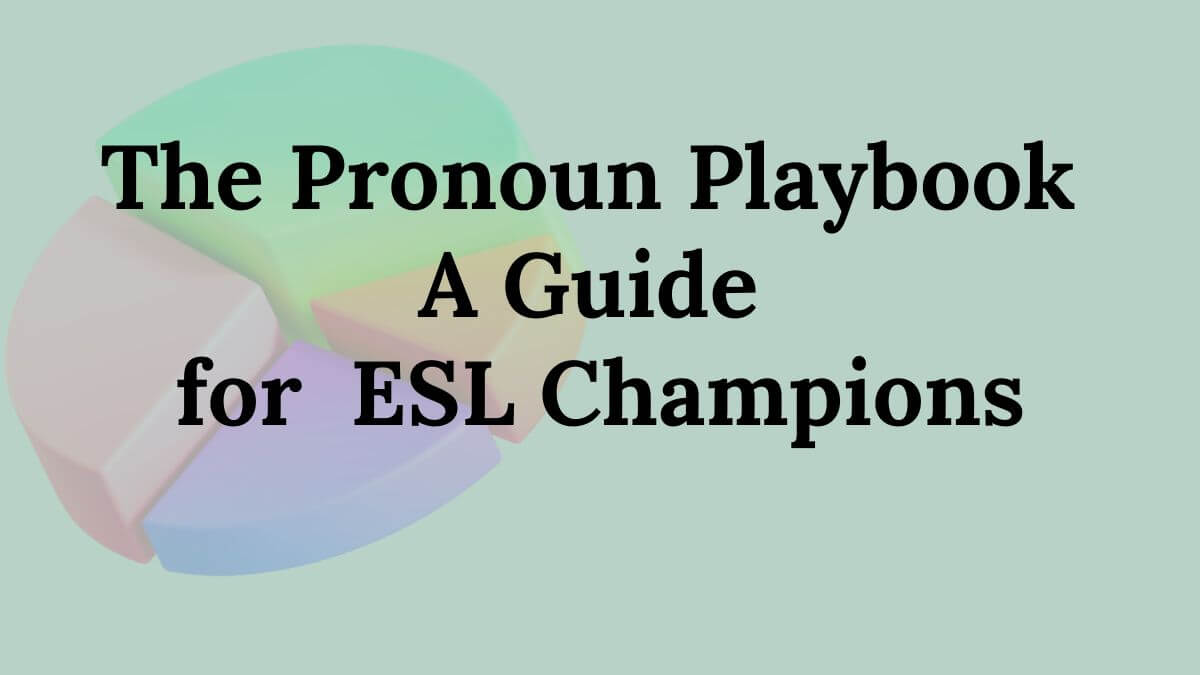Learning English as a second language can feel like a puzzle, but with the right playbook, you can master the pieces. One of the most important pieces? Pronouns. The Pronoun Playbook is here to guide ESL champions like you through the world of pronouns—those small but mighty words that help our sentences flow and our ideas make sense. Whether you’re writing, reading, or speaking English, using pronouns correctly can boost both your confidence and clarity.
The Pronoun Playbook
What Is a Pronoun and Why Does It Matter?
In simple terms, pronouns are words that replace nouns in a sentence. Instead of saying “Sarah loves Sarah’s cat,” we say, “Sarah loves her cat.” The word her is a pronoun—it saves time and avoids repetition. There are many types of pronouns in English, and each plays a different role. The more you practice using them correctly, the more natural your English will sound. Let’s dive deeper into this playbook so you can become a pronoun pro. The Pronoun Playbook
Types of Pronouns You Need to Know
Mastering pronouns means knowing the different types and when to use each one. This section of The Pronoun Playbook introduces the essential categories:
1. Subject Pronouns
These pronouns do the action in a sentence. They replace the subject (the person or thing doing something). The Pronoun Playbook
Examples:
- I, you, he, she, it, we, and they
She loves dancing.
They are studying English.
2. Object Pronouns
These pronouns receive the action in a sentence. These pronouns follow action—they trail the verb or preposition like a shadow, completing the meaning without stealing the spotlight. The Pronoun Playbook
Examples:
- Me, you, him, her, it, us, them
My teacher called me.
I’ll sit with them.
3. Possessive Pronouns
These show ownership or possession. Unlike possessive adjectives, these stand alone.
Examples:
- Mine, yours, his, hers, ours, theirs
This pen is mine.
Is that phone yours?
4. Reflexive Pronouns
Reflexive pronouns bounce the action back to the subject, ending in -self or -selves to show the doer and receiver are one and the same.
Examples:
- Myself, yourself, himself, herself, itself, ourselves, yourselves, themselves
I taught myself French.
They made it themselves.
5. Demonstrative Pronouns
These point to specific things.
Examples:
- This, that, these, those
This is my book.
Those are too expensive.
6. Interrogative Pronouns
Used to ask questions.
Examples:
- Who, whom, whose, which, what
Who is knocking?
Whose bag is this?
7. Indefinite Pronouns
Indefinite pronouns point to people or things in general—unspecified, unnamed, but understood in context. The Pronoun Playbook
Examples:
- Anyone, everyone, something, nobody, each, few
Someone left their umbrella.
Each of us has a story.
Why Pronouns Are Important for ESL Learners
If you’re learning English, pronouns help your speech sound more natural and fluent. They reduce repetition and make communication smoother. Without pronouns: Maria said Maria would help Maria’s friend.
With pronouns:
Maria said she would help her friend. Big difference, right? That’s the power of pronouns—and the reason The Pronoun Playbook exists. Tiny pronouns, big mistakes—learn how to fix them fast. Even advanced learners mix up pronouns sometimes. Here are some of the most common issues and tips from The Pronoun Playbook to fix them.
Mistake #1: Mixing Subject and Object Pronouns
I went to the store.
I went to the store.
She gave the book to me.
She gave the book to me.
Tip: Remember, I, he, she, we, and they are subjects. Me, him, her, us, and them are objects.
Read More:
10 Simple English Dialogues for Beginners: Grow Your Speaking Skills
Basic Sentence Structure Made Easy With Clear Examples
Mistake #2: Unclear Pronoun References
Emily told Anna that she was late. (Who was late—Emily or Anna?)
Emily said, “Anna, you’re late.” (Now it’s clear.)
Tip: Always make sure your pronoun clearly refers to the right noun. The Pronoun Playbook
Mistake #3: Forgetting Gender-Neutral Pronouns
English is evolving. More people use they/them as singular, gender-neutral pronouns. Alex said they would be late.
Sam brought their book.
Tip: Respect pronoun preferences. Use inclusive language where possible. The Pronoun Playbook
That’s my.
That’s mine.
Tip: Remember:
- My book (possessive adjective)
- The book is mine (possessive pronoun)
How to Practice Pronouns Like a Champion
Want to level up your skills? Follow these steps from The Pronoun Playbook:
1. Read Aloud and Listen Carefully
When you read books or watch English videos, listen for how pronouns are used. Pause and repeat the sentences. This helps reinforce natural patterns. The Pronoun Playbook
2. Write Sentences Using Different Pronouns
Choose a topic (like school, food, or your family) and write short sentences using each pronoun type. This helps build your confidence.
Example:
I love pizza.
My brother likes it too.
He makes it himself.
That’s his favorite.
3. Take Pronoun Quizzes
Online quizzes give quick feedback and help reinforce learning. Try 5–10 questions a day. Keep track of tricky pronouns and practice them more often. The Pronoun Playbook
4. Practice with a Friend or Language Partner
Use pronouns in conversation. Correct each other gently. Practice helps you get better faster.
